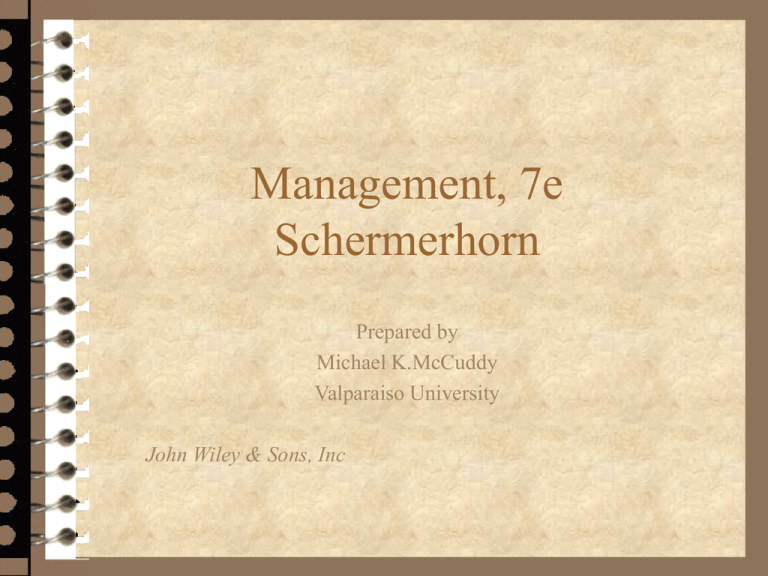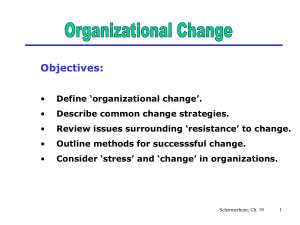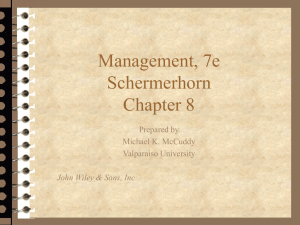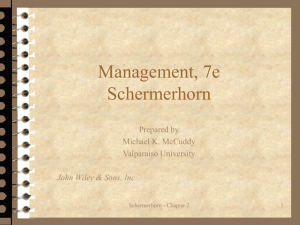
Management, 7e
Schermerhorn
Prepared by
Michael K.McCuddy
Valparaiso University
John Wiley & Sons, Inc
COPYRIGHT
Copyright 2002 © John Wiley & Sons, Inc. All rights reserved.
Reproduction or translation of this work beyond that named in
Section 117 of the United States Copyright Act without the express
written permission of the copyright owner is unlawful. Requests for
further information should be addressed to the Permissions
Department, John Wiley & Sons, Inc. The purchaser may make backup copies for his/her own use only and not for distribution or resale.
The Publisher assumes no responsibility for errors, omissions, or
damages, caused by the use of these programs or from the use of the
information contained herein.
Chapter 18
Change Leadership
Planning ahead—study questions
– What are the challenges of change?
– What is the nature of organizational change?
– How can planned organizational change be
managed?
– What is organization development?
– How do you build career readiness in a change
environment?
Schermerhorn - Chapter 18
3
What are the challenges of change?
Organizations that survive and prosper the best are
learning organizations.
Characteristics of learning organizations:
– Everyone sets aside the old ways of thinking.
– Everyone becomes self-aware and open to others.
– Everyone learns how the whole organization works.
– Everyone understands and agrees to a plan of action.
– Everyone works together to accomplish the plan.
Schermerhorn - Chapter 18
4
What are the challenges of change?
Six components of strategic leadership:
– Determining the organization’ purpose or vision.
– Exploiting and maintaining the organization’s core
competencies.
– Developing the organization’s human capital.
– Sustaining an effective organizational culture.
– Emphasizing and displaying ethical practices.
– Establishing balanced organizational controls.
Schermerhorn - Chapter 18
5
What are the challenges of change?
Innovation is the process of creating new
ideas and putting them into practice.
Two forms of innovation:
– Process
• Results in better ways of doing things.
– Product
• Results in the creation of new or improved goods
and services .
Schermerhorn - Chapter 18
6
What are the challenges of change?
Invention
– Act of discovery.
– Relates to the development of new ideas.
Application
– Act of use.
– The utilization of inventions to take the best advantage
of ideas.
Innovation = Invention + Application
Schermerhorn - Chapter 18
7
What are the challenges of change?
Leadership responsibilities for the
innovation process:
– Imagining
– Designing
– Experimenting
– Assessing
– Scaling
Schermerhorn - Chapter 18
8
What are the challenges of change?
Four steps of the product innovation
process:
– Idea creation
– Initial experimentation
– Feasibility determination
– Final application
Schermerhorn - Chapter 18
9
What are the challenges of change?
In highly innovative organizations,
corporate strategy and culture should …
– Emphasize an entrepreneurial spirit.
– Expect innovation.
– Accept failure.
– Be willing to take risks.
Schermerhorn - Chapter 18
10
What are the challenges of change?
In highly innovative organizations,
organization structure should …
– Be organic with lateral communications and
cross-functional teams and task forces.
– Create numerous smaller divisions to allow
creative teams to operate and to encourage
intrapreneurial ventures.
Schermerhorn - Chapter 18
11
What are the challenges of change?
In highly innovative organizations, staffing
should fulfill five critical innovation roles:
– Idea generators
– Information gatekeepers
– Product champions
– Project managers
– Innovation leaders
Schermerhorn - Chapter 18
12
What are the challenges of change?
In highly innovative organizations, top
management should …
– Understand the innovation process.
– Be tolerant of criticism and differences of
opinion.
– Take all possible steps to keep goals clear.
– Maintain the pressure to succeed.
– Break down barriers to innovation.
Schermerhorn - Chapter 18
13
What is the nature of organizational
change?
Change agent
– A person or group who takes leadership
responsibility for changing the existing pattern
of behavior of another person or social system.
Change leadership …
– Forward-looking
– Proactive
– Embraces new ideas
Schermerhorn - Chapter 18
14
What is the nature of organizational
change?
Top-down change
– Strategic and comprehensive change that is
initiated with the goals of comprehensive
impact on the organization and its performance
capabilities.
– Driven by the organization’s top leadership.
– Success depends on support of middle-level
and lower-level workers.
Schermerhorn - Chapter 18
15
What is the nature of organizational
change?
How to lead transformational change:
– Establish a sense of urgency for change.
– Form a powerful coalition to lead the change.
– Create and communicate a change vision.
– Empower others to move change forward.
– Celebrate short-term “wins” and recognize those who
help.
– Build on progress and success; align people and
systems with new ways.
– Stay with it; keep the message consistent; champion the
vision.
Schermerhorn - Chapter 18
16
What is the nature of organizational
change?
Theory E change
– A version of top-down change.
– Based on activities intended to increase
shareholder value as soon as possible.
– Emphasizes structural and systems changes.
– Attempts to gain employee support through
financial incentives.
Schermerhorn - Chapter 18
17
What is the nature of organizational
change?
Bottom-up change
– The initiatives for change come from persons
throughout an organization and are supported by the
efforts of lower-level and middle-level managers acting
as change agents.
– Crucial for organizational innovation.
– Made possible by:
• Employee empowerment
• Employee involvement
• Employee participation
Schermerhorn - Chapter 18
18
What is the nature of organizational
change?
Theory O change
– A version of bottom-up change.
– Based on activities for increasing organizational
performance capabilities by:
• Improving organizational culture.
• Developing human capital.
Schermerhorn - Chapter 18
19
What is the nature of organizational
change?
Planned and unplanned change
– Planned change …
• Occurs as a result of specific efforts of a change
agent.
• Direct response to perception of a performance gap.
– Unplanned change …
• Occurs spontaneously or randomly and without
benefit of a change agent’s attention.
• Acting immediately is the appropriate response goal.
Schermerhorn - Chapter 18
20
What is the nature of organizational
change?
External forces for change:
– Global economy and market competition
– Local economic conditions
– Government laws and regulations
– Technological developments
– Market trends
– Social forces
Schermerhorn - Chapter 18
21
What is the nature of organizational
change?
Internal forces for change:
– Arise when change in one part of the
organizational system creates the need for
change in another part of the system.
– May be in response to one or more external
forces.
Schermerhorn - Chapter 18
22
What is the nature of organizational
change?
Organizational targets for change:
– Tasks
– People
– Culture
– Technology
– Structure
Schermerhorn - Chapter 18
23
How can planned organizational
change be managed?
Phases of planned change
– Unfreezing
• The phase in which a situation is prepared for
change and felt needs for change are developed.
– Changing
• The phase in which something new takes place in
the system, and change is actually implemented.
– Refreezing
• The phase of stabilizing the change and creating the
conditions for its long-term continuity.
Schermerhorn - Chapter 18
24
How can planned organizational
change be managed?
Choosing a change strategy
– Force-coercion strategy
• Uses power bases of legitimacy, rewards and
punishment to induce change.
• Produces limited and temporary results.
• Most useful in the unfreezing phase.
Schermerhorn - Chapter 18
25
How can planned organizational
change be managed?
Choosing a change strategy
– Rational persuasion strategy
• Bringing about change through persuasion backed
by special knowledge, empirical data, and rational
argument.
• Relies on expert power.
• Useful in the unfreezing and refreezing phases.
• Produces longer-lasting and internalized change.
Schermerhorn - Chapter 18
26
How can planned organizational
change be managed?
Choosing a change strategy
– Shared power strategy
• Engages people in a collaborative process of
identifying values, assumptions, and goals from
which support for change will naturally emerge.
• Likely to yield high commitment.
• Relies on referent power and strong interpersonal
skills in team situations.
Schermerhorn - Chapter 18
27
How can planned organizational
change be managed?
Reasons for people resisting change …
– Fear of the unknown
– Disrupted habits
– Loss of confidence
– Loss of control
– Poor timing
– Work overload
– Loss of face
– Lack of purpose
Schermerhorn - Chapter 18
28
How can planned organizational
change be managed?
Methods for dealing with resistance to
change:
–
–
–
–
–
–
Education and communication
Participation and involvement
Facilitation and support
Facilitation and agreement
Manipulation and co-optation
Explicit and implicit coercion
Schermerhorn - Chapter 18
29
What is organization development?
Organization development (OD) is a
comprehensive approach to planned
organizational change that involves the
application of behavioral science in a
systematic and long-range effort to improve
organizational effectiveness.
Schermerhorn - Chapter 18
30
What is organization development?
Organization development goals:
– Outcome goals focus on task accomplishments.
– Process goals focus on the way people work together.
– OD seeks to develop the organization members’
capacity for self-renewal.
– OD endorses freedom of choice, shared power, and
self-reliance.
– OD takes advantage of knowledge about human
behavior.
Schermerhorn - Chapter 18
31
What is organization development?
The organization development process:
– Establish a working relationship
– Diagnosis
– Intervention
– Evaluation
– Achieve a terminal relationship
Schermerhorn - Chapter 18
32
What is organization development?
Action research
– The process of systematically collecting data on
an organization, feeding it back to the members
for action planning, and evaluating results by
collecting more data and repeating the process
as necessary.
– Is initiated when someone senses a performance
gap.
Schermerhorn - Chapter 18
33
What is organization development?
Steps in the action research process:
– Problem sensing
– Data gathering
– Data analysis and feedback
– Action planning
– Action implementation
– Evaluation and follow-up
Schermerhorn - Chapter 18
34
What is organization development?
Individual OD interventions
– Sensitivity training (T-groups)
– Management training
– Role negotiation
– Job redesign
– Career planning
Schermerhorn - Chapter 18
35
What is organization development?
Team OD interventions
– Team building
– Process consultation
– Inter-group team building
Schermerhorn - Chapter 18
36
What is organization development?
Organization-wide OD interventions
– Survey feedback
– Confrontation meeting
– Structural redesign
– Management by objectives (MBO)
Schermerhorn - Chapter 18
37
How do you build career readiness in a
change environment?
Key lessons for early career success …
– There is no substitute for performance.
– You must be flexible and stay that way.
– You must commit to continuous learning and
professional development.
Schermerhorn - Chapter 18
38
How do you build career readiness in a
change environment?
In developing your career …
– Behave like an entrepreneur.
– Seek feedback on your performance.
– Set up your own mentoring systems.
– Get comfortable with teamwork.
– Take risks to gain experience and learn new
skills.
– Be a problem solver.
– Keep your life in balance.
Schermerhorn - Chapter 18
39
How do you build career readiness in a
change environment?
Create a sustainable career advantage by building
a career portfolio that documents skills and
capabilities in …
–
–
–
–
–
–
Professionalism
Leadership
Self-management
Communication
Critical thinking
Teamwork
Schermerhorn - Chapter 18
40





